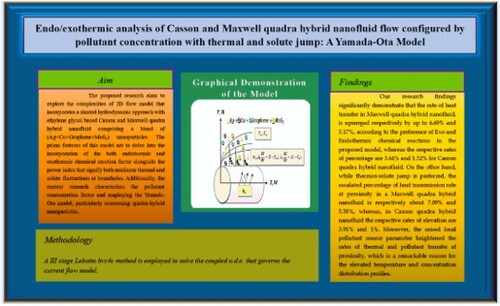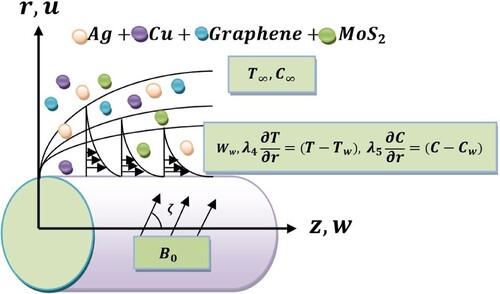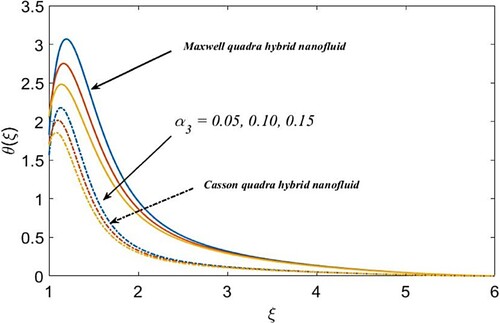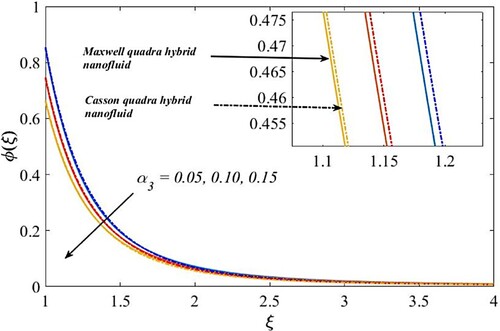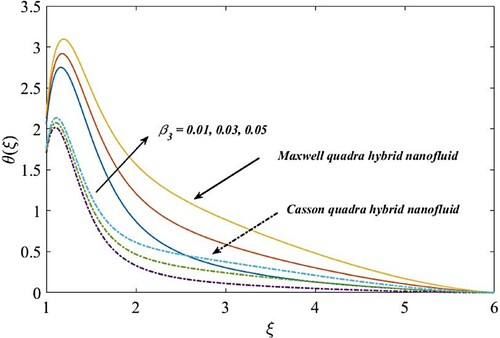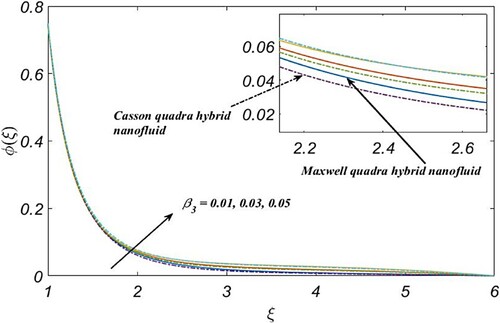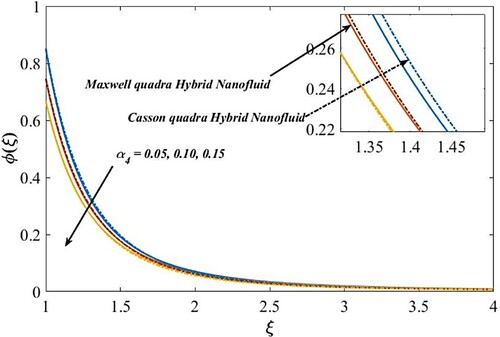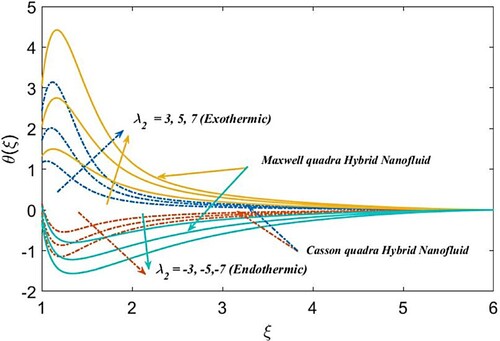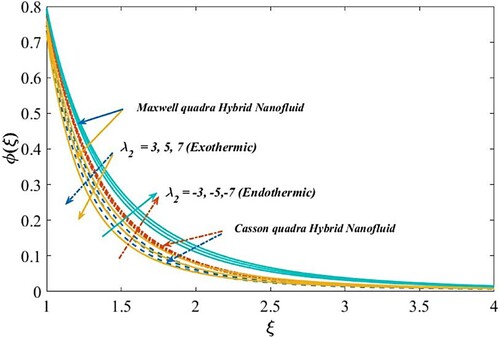 ?Mathematical formulae have been encoded as MathML and are displayed in this HTML version using MathJax in order to improve their display. Uncheck the box to turn MathJax off. This feature requires Javascript. Click on a formula to zoom.
?Mathematical formulae have been encoded as MathML and are displayed in this HTML version using MathJax in order to improve their display. Uncheck the box to turn MathJax off. This feature requires Javascript. Click on a formula to zoom.Abstract
This pioneering study aims to integrate a Yamada-Ota nanofluid model into the Casson-Maxwell quadrahybrid nanofluid framework, comprising a blend of (Ag + Cu + Graphene + MoS2) nanoparticles. This investigation explores the endothermic/exothermic reactions, Arrhenius energy and pollutant concentration within the confines of a stretching cylinder, addressing the thermal and solute jump at the boundary. It is significantly conferred that the heat transfer rate in Maxwell quadrahybrid nanofluid is upsurged respectively by up to 6.69% and 5.17%, with the respective preference of Exo and Endothermic chemical reactions, whereas the respective rates of percentage are 3.64% and 1.32% for Casson quadrahybrid nanofluid. Furthermore, as thermos and solute jumps are preferred, the escalated percentage of heat transmission rate at proximity in a Maxwell quadrahybrid nanofluid is about 7.09% and 5.58%, respectively, while the same elevation rates in Casson quadra hybrid nanofluid are 3.91% and 1% respectively, with elevated pollutant parameters further enhancing thermal and pollutant transfer rates.
Nomenclature
| = | Magnetic Factor | |
| = | Reynolds number | |
| = | Casson Parameter | |
| = | Non-dimensional Maxwell parameter | |
| = | Inclined angle | |
| = | Prandtl number | |
| = | Varying thermal conductivity | |
| = | Dimensionless Endo/Exothermicity | |
| = | Chemical reaction parameter | |
| = | Temperature ratio parameter | |
| = | Activation factor | |
| = | Varying thermal and mass index factor | |
| = | Local pollutant external source parameter | |
| = | Thermal jump | |
| = | Concentration jump | |
| = | External pollutant source variation parameter |
1. Introduction
Hybrid nanofluid comprises a synergistic amalgamation of nanoparticles uniformly dispersed within a base fluid medium, leveraging their attributes. Strategically crafted to augment heat transfer efficiency, it pervades domains like thermal management systems, heat exchangers, and biomedical apparatus. Its meticulously tailored formulation accentuates thermal conductivity and fluidic dynamics, engendering multifaceted advantages across industrial spectra. In their study, Paul et al. [Citation1] employed numerical methods to scrutinize the heat transfer dynamics of magneto-hydrodynamic (MHD) Cu/Al2O3-H2O Casson-hybrid-nanofluid flowing over an exponentially stretching cylinder augmented with a heat source. Their findings offer promising prospects for refining heat transfer optimization across a diverse array of engineering contexts. Furthermore, Bharathi et al. [Citation2] scrutinized the intricacies of heat transfer within electromagnetic-hydrodynamic (EMHD) hyperbolic tangent ternary hybrid nanofluid flow over a Darcy-Forchheimer porous wedge surface. Their study significantly augmented comprehension concerning the utilization of nanomaterials and nano liquids in the optimization of heat transfer phenomena. Moreover, Paul et al. [Citation3] meticulously investigated the intricacies of thermally stratified Cu–Al2O3/water hybrid nanofluid flow, incorporating the impact of an inclined magnetic field, viscous dissipation, and heat source/sink phenomena on a vertically stretching cylinder. Their study constitutes a substantial advancement in comprehending the multifaceted fluid dynamics and heat transfer phenomena under diverse environmental contexts. In a recent survey, Awan et al. [Citation4] conducted a numerical analysis of thermal transport within the Ellis hybrid nanofluid flow over a stretching cylinder. Furthermore, Almeshaal et al. [Citation5] simulated diffusive nanofluid flow with multiple slip effects.
In the investigation of Casson and Maxwell hybrid nanofluid flow over a stretched cylinder, the intricate interplay of yield stress from Casson fluids and the viscoelastic characteristics inherent to Maxwell fluids profoundly shape fluid dynamics. Mastery of this nuanced flow regime facilitates the optimization of diverse processes, including cooling systems and biomedical apparatus. Applications encompass heightened heat transfer efficacy in thermal regulation systems and refined drug delivery methodologies, exemplified by modelling vascular fluid dynamics. Alwawi et al. [Citation6] delved into the nuanced complexities of mixed convection phenomena within magnetized Casson nanofluid dynamics surrounding a cylindrical surface. Their comprehensive investigation unveiled that increasing either the mixed convection parameter or the volume fraction of ultrafine particles exerts a significant amplifying effect on energy transport rates, skin friction, and velocity distribution.
Moreover, Algehyne et al. [Citation7] embarked on a rigorous examination elucidating the intricate heat distribution characteristics inherent in the magneto-hydrodynamic (MHD) mixed convective flow of a Casson hybrid nanofluid over an exponentially stretching surface. Their study meticulously accounted for the intricate interplay of chemical reactions and ohmic heating. Concurrently, Paul et al. [Citation8] focused on dissecting the thermal and mass transfer dynamics observed in Casson-Maxwell hybrid nanofluids cascading around an unsteady horizontal cylinder. Their analysis meticulously incorporated variations in thermal conductivity and Arrhenius activation energy. Noteworthy findings from their exploration underscored significant alterations in skin friction performance, thereby emphasizing the profound impact of the amalgamation of Casson and Maxwell hybrid nanofluid models. Few researchers [Citation9–11] have contributed substantially to the burgeoning domain of Casson-Maxwell nanofluids in the contemporary scientific landscape. In recent years, Shahzad et al. [Citation12], Alkathiri et al. [Citation13] and Ouni et al. [Citation14] investigated thermal case study over parabolic solar collector using nanofluid.
Exothermic reactions release heat (positive heat), essentially giving you a heating effect, and endothermic reactions absorb heat (negative heat), providing a cooling effect. These reactions can play an essential role in changing a fluid’s temperature distribution and heat transfer features. Arrhenius energy delineates the threshold activation energy imperative for catalysing chemical reactions, thereby modulating reaction kinetics. In short, Exothermic reactions liberate thermal energy, contrasting with endothermic reactions that absorb it. In industrial realms, cognisance of Arrhenius energy facilitates fine-tuning reaction parameters for maximal efficacy. Exothermic reactions underpin thermal processes like internal combustion, while endothermic reactions feature prominently in refrigeration systems. Mastery of these tenets empowers engineers to craft bespoke methodologies and technologies attuned to precise energy requisites, thus propelling advancements across domains spanning chemical synthesis to environmental engineering. Sarve et al. [Citation16] conducted a meticulous numerical simulation to explore the intricate influence of activation energy on the Darcy-Forchheimer flow dynamics of Casson fluid laden with nanoparticles around a stretching cylinder.
Meanwhile, Majeed et al. [Citation17] undertook a theoretical investigation to elucidate the ramifications of Arrhenius activation energy on the complex radiative magneto-hydrodynamic nanofluid flow, encompassing heat and mass transfer phenomena over a porous cylinder. Their insightful studies unveiled a nuanced interplay, showcasing a concurrent reduction in temperature alongside an escalation in velocity as the mixed convection parameter was augmented. Furthermore, Sajid et al. [Citation18] delved into the intricate interplay of endo/exothermic chemical processes on tri-hybrid nanofluids flowing over a wedge, subject to convective boundary constraints and variations in activation energy. Their discerning analysis unearthed heightened thermal conductivity with tri-hybrid nanoparticles compared to their hybrid counterparts while highlighting a reduction in heat transfer rates attributable to exothermic reactions.
Pollutant concentration is the concentration of contaminant particles or detrimental substances in a fluid. When speaking about fluid flow studies, for instance, this usually indicates the quantity of these pollutants when dispersed in nanofluid solutions, and those again can modify their properties, thus influencing the behaviour of encapsulated fluids. Also, pollutant concentration denotes the quantification of deleterious substances within an environment, which is pivotal for evaluating ecological integrity and human health ramifications. Jump temperature and jump concentration delineate phenomena observed at fluid-solid interfaces. Jump temperature signifies the rapid thermal transition across said interface, stemming from thermal impedance. Conversely, jump concentration elucidates the abrupt shift in solute or pollutant levels at the interface. These concepts permeate diverse disciplines, including environmental science, chemical engineering, and materials science. Proficiency in comprehending jump temperature and concentration facilitates the design of proficient heat exchangers, optimization of pollutant mitigation strategies, and augmentation of material performance interfacing with fluids. Li et al. [Citation19] delved into the intricacies of utilizing an induced magnetic field for enhancing heat and mass transfer within the ferromagnetic hybrid nanofluid flow driven by variations in pollutant concentration. Their investigation revealed intriguing insights; while motor oil exhibits efficacy in endothermic scenarios, water-based hybrid nano liquids significantly influence heat transfer dynamics, particularly over the activation energy component in exothermic chemical reactions. Moreover, water-based nanofluids demonstrated superior pollutant mitigation capabilities compared to engine oil when subjected to local pollutant external source parameters. These findings offer valuable implications for optimizing thermal management systems and environmental remediation strategies.
Reckoning pollutant concentration and endo/exothermic effects in the same frame is vital for numerous purposes. Pollutants have the ability to vary fluid viscosity as well as heat conductivity, affecting the inclusive flow dynamics. Furthermore, endo/exothermic reactions seem to impact the temperature diffusion field, which in turn stimulates the fluid’s viscosity and the pollutant’s distribution rate. These factors are crucial for accurately modelling and predicting the behaviour of complex fluids like Casson-Maxwell quadra hybrid nanofluids, mainly when these fluids are used in systems where precise control of temperature and concentration is necessary. These phenomena include the interaction of pollutant concentration with endo/exothermic reactions in chemical reactors, which is critical for optimizing reaction conditions, yield improvement, and safety. Also, accurate modelling of the interaction of certain pollutants with nanofluids is likely to enhance pollutant removal efficiency from industrial emissions in pollution control devices (e.g. scrubbers and filters). In addition, nanofluids, with their endo/exothermic reactions that could absorb or dispel heat, allow for thermal regulation using the fluid in both aspects, resulting in more efficient heat conditioning systems.
The Yamada-Ota model stands as a prominent theoretical construct extensively employed for scrutinizing the thermal conductivity behaviours inherent in nanofluids. Its application spans multifarious domains, notably within the realm of hybrid nanofluids investigation. This model enables meticulous prognostications of thermal conductivity enhancements by meticulously accounting for parameters intrinsic to hybrid systems, such as nanoparticle composition and concentration. Its profound insights are invaluable assets for refining cutting-edge cooling and heating systems across diverse sectors encompassing automotive engineering, electronics, and renewable energy. Ultimately, the Yamada-Ota model catalyses the development of heightened efficiency and efficacy in modern thermal management solutions, thereby perpetuating advancements in technological frontiers. Chu et al. [Citation20] undertook a meticulous comparative study, delving into the intricacies of model-based magnetohydrodynamics governing the unsteady flow of hybrid nanofluids confined between two infinite parallel plates, taking into account the influence of particle shape. Their analysis uncovered intriguing findings, revealing that the Yamada-Ota model outperforms the Hamilton-Crosser model in predicting heightened temperature and velocity profiles within hybrid nanofluid systems. Concurrently, Sajid et al. [Citation21] delved into an investigation exploring the effects of radiative and porosity phenomena on trihybrid Casson nanofluids subjected to Bödewadt flow and varying heat sources, utilizing both the Yamada-Ota and Xue models for a comprehensive analysis. These studies significantly contribute to understanding the intricate dynamics governing hybrid nanofluids, thereby offering crucial insights for advancing thermal management technologies. Mahmood et al. [Citation22] recently analysed the combined convective flow of hybrid nanofluid at the stagnation point over the sheet, incorporating varying heat conductivity utilizing the Yamada-Ota model. In recent years, some researchers such as Nabwey et al. [Citation15] , Vaidya et al. [Citation26], Hussain et al. [Citation27], Khan et al. [Citation28], Upreti et al. [Citation29], Ahmed et al. [Citation30] provided their valuable contribution through their innovation in the field of engineering that relates to the mechanism of thermal transportation.
The prescribed model acquaints with numerous novel features in the dynamics of nanofluid flow research that primarily includes the utilization of four distinct nanocomposites in Casson and Maxwell fluid, which augments the thermal and solute transmission characteristics. Moreover, the variations or jumps in solute and thermal characteristics proximate to the boundary have been promptly addressed for precise and accurate solute and heat transportation modelling. Furthermore, the current model incorporates the concentration of pollutants, which is beneficial from an environmental perspective. A few elements, such as ,
and
(in tiny amounts) are crucial in promoting improvements in plant and animal physiques. At last, the addition of exothermic and endothermic reactions provides a novel aspect to the model as it aligns with the pragmatism of the solute and heat diffusion process.
1.1. A distinct feature of the model being presented compared to the existing literature
The study highlights a notable research gap concerning the investigation of quadra Casson-Maxwell hybrid nanofluid flow around a stretched cylinder, incorporating Arrhenius energy, endothermic, and exothermic reactions and pollutant concentration which remains unexplored in existing literature. This research presents a novel approach by integrating the Yamada and Ota nanofluid models, particularly in the context of quadra-hybrid nanoparticles, a pioneering endeavour in this domain. Computational solutions for the mass and temperature profiles, alongside heat and mass transfer rates of the quadra hybrid nanofluid, were obtained by solving the formulated mathematical model using the MATLAB BVP4c Method. This study advances our understanding of complex fluid dynamics and offers valuable insights for future research in thermal engineering and nanofluid applications.
1.2. Application of the present model
Integrating Casson-Maxwell hybrid nanofluid dynamics over a stretched cylinder, incorporating Arrhenius energy and endothermic/exothermic reactions, and leveraging the Yamada-Ota model offers multifaceted applications across diverse disciplines. These include enhancing cooling systems in automotive engineering, optimizing heat exchangers in industrial processes, and refining thermal management in electronics. Through precise prognostication of temperature and velocity profiles and heat and mass transfer rates, this study fosters the development of sophisticated cooling and heating technologies. Furthermore, it catalyses the advancement of sustainable and energy-efficient systems, addressing contemporary challenges in thermal engineering and nanofluidic applications. Ultimately, this endeavour significantly advances our understanding of fluid dynamics, promising innovative solutions to address multifaceted challenges across diverse industrial and engineering sectors.
The prevailing literature aforementioned signifies that no prior investigation has been conducted regarding thermal and Solute jump impacts on Endo/exothermic analysis of Casson and Maxwell quadra hybrid nanofluid flow configured by pollutant concentration over exponentially stretched cylinder. Therefore, a physical model has been formulated to unearth the following research questions/objectives:
What are the thermal and mass transfer characteristics under the specified conditions?
To discuss the contrastive impacts of Casson and Maxwell quadra hybrid nanofluid flow on the thermal and mass profile.
How does the thermal and mass distribution profile be affected by the thermal and solute jump, pollutant source factor, End/exothermic chemical reaction?
What insights can be drawn on the heat transfer rate and mass transfer rate with and without thermal and solute jump?
How does Casson-Maxwell quadra hybrid nanofluid influence the thermal and mass features, in contrast to single nanoparticle blended Casson-Maxwell nanofluid?
2. Mathematical formulation
The proposed research explores the complexities of the 2D flow model that incorporates a slanted hydrodynamic approach with ethylene glycol-based Casson and Maxwell quadra hybrid nanofluid comprising a blend of (Ag + Cu + Graphene + MoS2) nanoparticles. This model’s prime features are to incorporate both endothermic and exothermic chemical reaction factors alongside the power index that signifies both nonlinear thermal and solute fluctuations at boundaries. Additionally, the current research characterizes the pollutant concentration factor and employs the Yamada-Ota model, particularly concerning quadra-hybrid nanoparticles. Furthermore, this flow dynamic under investigation is considered to have originated from the exponentially stretched/elongated cylinder having a radius, a0 oriented in the positive direction of axis, exerted by the influences of thermal and solute jump. The flow velocity at the proximity of the exponentially stretched vertical cylinder is regarded as
, where
is specified as the stretching rate. As depicted in Figure , The temperature and concentration proximate to the exponentially stretched/elongated horizontal cylinder are signified as
and
are presumed to vary non-linearly with the temperature and concentration at infinity, i.e.
and
. The representation of the geometric model is depicted in Figure as follows:
The array of partial differential equations that govern the suggested Casson and Maxwell quadra hybrid Yamada-Ota nanofluid flow model (Li et al. [Citation19], Sajid et al. [Citation18], Paul et al. [Citation8], Adhikari & Das [Citation11])
Continuity equation:
(1)
(1)
Momentum boundary layer equation:
(2)
(2)
Thermal boundary layer equation:
(3)
(3)
Concentration boundary layer equation:
(4)
(4)
The proposed boundary constraints are as follows: (Alshahrani et al. [Citation25], Paul et al. [Citation1])
(5)
(5)
(6)
(6)
The pertinent similarity transformations: (Pan et al. [Citation10], Paul et al. [Citation1])
(7)
(7)
After putting in the similarity transformation variables in Eqs. (2)–(6), we acquired the following non-dimensional coupled equations
(8)
(8)
(9)
(9)
(10)
(10)
The corresponding boundary limitations are:
(11)
(11)
The skin friction, thermal and mass transmission rates are demonstrated as follows:
(12)
(12)
3. Consecutive equations for Yamada-Ota model
3.1. Representation of variables for quadra hybrid nanofluid as per Yamada-Ota model
Density
.Here,
,
,
,
are the vol. concentration of
and
respectively;
,
,
,
signifies the densities of
and
respectively.
Ratio of Dynamic viscosity
Ratio of Thermal conductivity
Here, denotes the thermal conductivities of
and
nanoparticle.
Ratio of Specific heat capacity
Electric conductivity
Here,,
,
,
are the specific heat capacity of
and
nanoparticles and
,
,
,
denotes the Electric conductivity of
and
nanoparticle.
4. Methodology
To initiate, the non-dimensional higher-order ordinary differential equations (ODEs) (8)–(10) transform an intermediate first-order boundary value problem, accompanied by the pertinent boundary impediments (11). Employing the renowned bvp4c algorithm embedded within MATLAB, alongside a shooting technique, facilitates the numerical resolution of these non-dimensional ODEs. Even grappling with intricate and chaotic formulations, the bvp4c decoder ensures precision by adeptly handling boundary value challenges (Majid et al. [Citation13]). Its robust mesh refinement capability alleviates computational overhead while concurrently augmenting computational efficiency. However, achieving an initial estimate conforming to the spatial constraints of the bvp4c solver is imperative for its utilization. The preeminent method for approximating the numerical solution of such non-dimensional complex ODEs lies in leveraging bvp4c, which sets its convergence threshold at , surpassing those attained by alternative methodologies. In fact, the convergence criterion of
set by the bvp4c solver is one of the most important standards in some numerical methods in dealing with stiff ODEs. This threshold represents what level of accuracy is considered acceptable for a numerical solution to be valid and applicable for practical purposes. Convergence below this threshold guarantees to get a result close to the exact solution of the differential equation according to a predefined tolerance. Consequently, the bvp4c solver iterates until the computed solution satisfies an accuracy of 10−4 regarding the greatest residual norm. Residual norms express the error between the linear approximation’s solution and the differential equation’s exact solution at every iteration step. This residual is diminished over the concurrent refinement of an approximation by the solver and typically to zero as the solver attenuates its action, involving iterative mesh adjustments and numerical tactics.
Now, considering the vector,
It is established whereby each component corresponds to specific variables and their derivatives, and the numerical analysis proceeds.
5. Credibility of the outcome
For authentication of credibility, a comparative evaluation is conducted, harmonizing the findings acquired from Wang [Citation23] and Ishak et al. [Citation24]. It involves the exclusion of the energy equation and the removal of particular parameters in the momentum boundary layer equation. The results displayed in Table seamlessly correspond with the current dataset, thereby fortifying the methodology’s reliability.
6. Results and discussion
The proposed study aims to investigate the intricacies of a 2-dimensional flow model incorporating Ethylene Glycol-based slanted Hydrodynamic (MHD) Casson and Maxwell quadra-hybrid nanofluid, comprising a blend of (Ag + Cu + Graphene + MoS2) nanoparticles. This research focuses on integrating Arrhenius energy and both endothermic and exothermic chemical reactions, a terrain largely unexplored in extant literature. Additionally, the study seeks to characterize the power index, serving as a gauge for nonlinear thermal and solutal fluctuations at boundaries. Furthermore, this investigation introduces a pioneering approach by integrating the pollutant concentration factor and utilizing the Yamada and Ota nanofluid model, particularly in the realm of quadra-hybrid nanoparticles. The flow dynamics under scrutiny are anticipated to emanate from an exponentially stretched cylinder with a radius represented by, aligned along the positive z-axis direction. The flow scenario is also influenced by temperature and solute jumps. The thermophysical properties of both the base fluid and nanoparticles are elucidated in Table .
Table 1. The thermophysical attributes of the foundational fluid and nanoparticles.
The mathematical formulation of the problem is elaborated upon, delineating a set of partial differential equations to capture fluid flow, heat and mass transfer, and nanoparticle dispersion phenomena. Subsequently, these equations are transformed into a non-dimensional form to facilitate numerical solutions. The Bvp4c method is employed to simulate mass and heat transfer profiles, and a systematic analysis is conducted to discern the influences of various factors.
As shown in Figure , heightened thermal jump reduces the thermal profile of both Casson and Maxwell quadra hybrid nanofluid, configured by escalated thermal transmission in proximity to the cylindrical base and fluid surface. As the thermal jump escalates, the thermal gradient amplifies within the boundary region, surging the rate of heat transfer from the cylindrical surface to the fluid. Consequently, this engenders a thicker thermal boundary layer and accelerated elevation in fluid temperature near the interface. As a consequence, the overall temperature gradient intensifies, culminating in the attribution of thermal profile. In essence, the amplified temperature difference fosters more effective heat transfer, leads to a conspicuous thermal elevation near the solid surface and corresponds to a decline in the thermal profile throughout the convective region.
Again, a rise in the thermal jump enhances the scattering of particles of solutes due to heightened fluid blending and convective flow. This leads to a more homogeneous spread across both the Casson and Maxwell fluids, reducing the concentration disparities. More robust convective currents expedite diffusion, evening out concentration discrepancies. Therefore, as displayed in Figure , with the augmented thermal jump, the concentration profile decreases owing to hastened mixing and dispersion processes.
As increases, the concentration gradient decreases, a clear indication of pollutant transfer in the Casson and Maxwell fluid system from the cylindrical surface. The consequence of augmented local pollutant source parameters has been observed in the intensified heat and pollutant transfer rate, convective blending and dispersion within the fluid, which results in the elevated temperature and solutal profile as shown in Figures and . The elevation in both thermal and concentration profiles appears to be greater in Maxwell quadra hybrid nanofluid than in Casson quadra hybrid nanofluid. The key reasons behind the aforementioned discussion include that as the pollutants undergo exothermic chemical reactions, they dispel heat, which exhibits greater temperature close to the surface in contrast to the farther region. Again, more significant amounts of Pollutants lead to Increased concentrations around the source via steeper concentration gradients in the fluid in a region, and these increased concentration gradients drive diffusion and, extension, dispersion processes, promote more spreading of pollutants throughout the fluid, which is a cause of greater concentration diffusion.
Since the concentration gap widens within the system, the thermal and solutal distribution profiles decline, as portrayed in Figures and . A notable concentration difference indicates a sudden shift of concentration at a boundary or the interface with the medium. This leads to a steep variation in concentration levels, prompting the movement of particles from areas of high concentration to those of low concentration until the equilibrium is achieved. Likewise, in thermal scenarios, heat naturally tends to flow from hotter regions to cooler ones. As particles diffuse to balance the concentration gradient and heat moves to even out temperature fluctuations, both concentration and thermal distributions become more consistent across the system. As a consequence, there is a reduction in both profiles as the disparities in concentration and temperature between various sections lessen.
The positive value of indicate the exothermicity, while the negative value represents endothermicity. In Casson and Maxwell quadra hybrid nanofluid, with the augmentation of exothermic parameters, more heat is released, broadening the thermal distribution profile by elevating the temperature within the fluid, as shown in Figure . This accelerates the reaction rates, leading to faster consumption of particles/reactants and a decrease in their concentration over time, as shown in Figure . Conversely, increasing endothermicity is a clear indication of absorbing more heat, shrinking the thermal distribution profile by lowering the temperature, which is also portrayed in Figure . This causes a slowdown in reaction rate, resulting in lower consumption of reactants/particles, leading to a gradual increase in the concentration over time, as depicted in Figure . Moreover, in the context of exothermicity, in contrast to Casson quadra hybrid nanofluid, the thermal distribution profile of Maxwell quadra hybrid nanofluid elevates more.
The impact of thermal and solute variation index (), local pollutant source parameter
, thermal ratio parameter
, in the context of exothermicity and endothermicity with and without thermos-solute jump over Nusselt and Sherwood factor is displayed in Tables and for Maxwell and Casson flow. With the intensified value of
, the absolute thermos-transfer rate appears to decrease. In the context of exothermicity, the absolute solute transfer rate decreases with augmented
, but the reverse is the trend for
. Regarding endothermicity, the Sherwood number enhances for both
. Again, for both exothermic and endothermic chemical reactions, the Nusselt number exhibits an augmented value with
and
. But in the context of endothermicity, the absolute Sherwood number decreases with increasing values of
. It is significantly observed that, in a Maxwell quadra hybrid nanofluid, without thermos-solute jump factor, the rate of heat transfer is increased by up to 6.69% and 5.17% in concern with an Exo and Endo thermic chemical reaction, respectively. On the other hand, the increased percentage of heat transmission rate is about 7.09% and 5.58%, respectively, while thermos-solute jump is considered. When it comes to Casson quadra hybrid nanofluid, the absolute rate of heat transfer is increased by up to 3.64% and 1.32% in an Exo and Endo thermic chemical reaction, respectively. Meanwhile, the increased percentage of heat transmission rate is about 3.91% and 1%, respectively, while the thermos-solute jump is considered (Table ).
Table 2. Analogize findings with Wang [Citation23] and Ishak et al. [Citation24].
Table 3. Comparison between Maxwell fluid and Maxwell Hybrid Nanofluid regarding Nusselt and Sherwood number in the context of Endothermic and Exothermic chemical reaction with and without thermal and solute jump.
Table 4. Comparison between Casson fluid and Casson Hybrid Nanofluid regarding Nusselt and Sherwood number in the context of Endothermic and Exothermic chemical reaction with and without thermal and solute jump.
7. Conclusions
The research underscores a significant gap in current literature regarding examining flow around an elongated/stretched cylinder using Casson–Maxwell quadra hybrid nanofluid while also incorporating Arrhenius energy and reactions, both endothermic and exothermic. This study introduces an innovative approach by amalgamating the Yamada and Ota nanofluid models, primarily focusing on quadra-hybrid nanoparticles, a pioneering venture in this field. Using the Matlab BVP4c Method, computational solutions are derived for mass and temperature profiles and heat and mass transfer rates of the quadra hybrid nanofluid based on the formulated mathematical model. Key highlights of the findings are listed below:
The heightened thermal and solute jump reduces the convective region’s thermal and solute distribution profile for both Casson and Maxwell quadra hybrid nanofluid owing to hastened mixing and diffusion processes.
As the value of
and
intensify, there is a noticeable decrease in the absolute thermos-transmission rate at the proximity of the solid-fluid interface. Concerning the exothermic process, the absolute solute transfer rate diminishes with increased
, whereas the revert trend is observed for
. Conversely, in endothermic scenarios, there is an enhancement in the Sherwood number for both
and
.
The augmented local pollutant source parameter leads to heightened rates of heat and pollutant transfer and enhanced convective mixing within the fluid, which ultimately results in elevated temperature and concentration distribution profiles.
In a Maxwell quadra hybrid nanofluid, without thermos-solute jump factor, the rate of heat transfer is increased by up to 6.69% and 5.17% in concern with an Exo and Endo thermic chemical reaction, respectively, whereas the respective rates of percentage are 3.64% and 1.32% for Casson quadra hybrid nanofluid.
The escalated percentage of heat transmission rate at proximity in a Maxwell quadra hybrid nanofluid is respectively about 7.09% and 5.58%, while thermos-solute jump is considered, whereas the respective rates of percentage are 3.91% and 1% for Casson quadra hybrid nanofluid.
Disclosure statement
No potential conflict of interest was reported by the author(s).
Data availability statement
No datasets were analysed or generated during the present study.
References
- Paul A, Das TK, Nath JM. Numerical investigation on the thermal transportation of MHD Cu/Al2O3-H2O Casson-hybrid-nanofluid flow across an exponentially stretching cylinder incorporating heat source. Phys Scr. 2022;97:085701. doi:10.1088/1402-4896/ac7981
- Bharathi V, Prakash J, Tripathi D, et al. Heat transfer in EMHD hyperbolic tangent ternary hybrid nanofluid flow over a Darcy-Forchheimer porous wedge surface: a numerical simulation. Nanomater Nanoliq Appl Energ Environ. 2023: 249–279. doi:10.1007/978-981-99-6924-1_13
- Paul A, Nath JM, Das TK. Thermally stratified Cu–Al2O3/water hybrid nanofluid flow with the impact of an inclined magnetic field, viscous dissipation and heat source/sink across a vertically stretching cylinder. ZAMM J Appl Math Mech. 2023; 104: e202300084. doi:10.1002/zamm.202300084
- Awan AU, Ali B, Shah SAA, et al. Numerical analysis of heat transfer in Ellis hybrid nanofluid flow subject to a stretching cylinder. Case Stud Therm Eng. 2023;49:103222. doi:10.1016/j.csite.2023.103222
- Almeshaal MA, Majeed A, Ijaz N, et al. Numerical simulations for thermally developed double diffusion flow of nanoparticles due to elongated cylinder with multiple slip effects. Appl Energy Storage Syst Num Heat Transf Part A Appl. 2024: 1–16. doi:10.1080/10407782.2024.2321519
- Alwawi FA, Hamarsheh AS, Alkasasbeh HT, et al. Mixed convection flow of magnetised Casson nanofluid over a cylindrical surface. Coatings. 2022;12(3):296. doi:10.3390/coatings12030296.
- Algehyne EA, Alamrani FM, Khan A, et al. On thermal distribution of MHD mixed convective flow of a Casson hybrid nanofluid over an exponentially stretching surface with impact of chemical reaction and ohmic heating. Colloid Polym Sci. 2024; 302: 503–516. doi:10.1007/s00396-023-05214-x
- Paul A, Sarma N, Patgiri B. Thermal and mass transfer analysis of Casson-Maxwell hybrid nanofluids through an unsteady horizontal cylinder with variable thermal conductivity and Arrhenius activation energy. Numer Heat Transf Part A Appl. 2023: 1–26. doi:10.1080/10407782.2023.2297000.
- Nawaz M, Arif U. Numerical investigation on effects of entropy generation and dispersion of hybrid nanoparticles on thermal and mass transfer in MHD Maxwell fluid. J Therm Anal Calorim. 2022;147(23):13551–13560. doi:10.1007/s10973-022-11489-z.
- Pan H, Yousaf A, Imran M, et al. Numerical simulation of Maxwell nanofluid with MHD and bio-convective flow passing through a stretching cylinder. Int J Thermofluids. 2023;20:100423. doi:10.1016/j.ijft.2023.100423.
- Adhikari R, Das S. Biological transmission in a magnetised reactive Casson–Maxwell nanofluid over a tilted stretchy cylinder in an entropy framework. Chin J Phys. 2023;86:194–226. doi:10.1016/j.cjph.2023.10.008.
- Shahzad F, Jamshed W, Safdar R, et al. Thermal analysis characterisation of solar-powered ship using Oldroyd hybrid nanofluids in parabolic trough solar collector: an optimal thermal application. Nanotechnol Rev. 2022;11(1):2015–2037. doi:10.1515/ntrev-2022-0108
- Alkathiri AA, Jamshed W, Eid MR, et al. Galerkin finite element inspection of thermal distribution of renewable solar energy in presence of binary nanofluid in parabolic trough solar collector. Alexandr Eng J. 2022;61(12):11063–11076. doi:10.1016/j.aej.2022.04.036
- Ouni M, Ladhar LM, Omri M, et al. Solar water-pump thermal analysis utilizing copper–gold/engine oil hybrid nanofluid flowing in parabolic trough solar collector: Thermal case study. Case Stud Therm Eng. 2022;30:101756. doi:10.1016/j.csite.2022.101756.
- Nabwey HA, Reddy Minnam Reddy V, Suresh Babu R, et al. Enhanced heat transmission in hydrodynamic Maxwell and Jeffrey cylindrical film flows: a computational numerical simulation. Proc Inst Mech Eng Part E J Process Mech Eng. 2023;237(6):2457–2465. doi:10.1177/09544089221136439.
- Sarve D, Gaur PK, Sharma VK. Numerical simulation for activation energy impact on Darcy-Forchheimer flow of Casson fluid suspended with nano particles over a stretching cylinder. Sci Technol Asia. 2021; 26: 106–114. https://ph02.tci-thaijo.org/index.php/SciTechAsia/article/view/245885
- Majeed A, Zeeshan A, Ahmad QA, et al. Theoretical investigation of Arrhenius activation energy on radiative magneto-hydrodynamic nanofluid flow with heat and mass transfer over a porous cylinder. Waves Random Complex Media. 2023: 1–22. doi:10.1080/17455030.2023.2290652
- Sajid T, Al Mesfer MK, Jamshed W, et al. Endo/exothermic chemical processes influences of tri-hybridity nanofluids flowing over wedge with convective boundary constraints and activation energy. Results Phys. 2023;51:106676. doi:10.1016/j.rinp.2023.106676
- Li S, Saadeh R, Madhukesh JK, et al. Aspects of an induced magnetic field utilisation for heat and mass transfer ferromagnetic hybrid nanofluid flow driven by pollutant concentration. Case Stud Therm Eng. 2024;53:103892. doi:10.1016/j.csite.2023.103892
- Chu YM, Bashir S, Ramzan M, et al. Model-based comparative study of magnetohydrodynamics unsteady hybrid nanofluid flow between two infinite parallel plates with particle shape effects. Math Methods Appl Sci. 2023;46(10):11568–11582. doi:10.1002/mma.8234.
- Sajid T, Pasha AA, Jamshed W, et al. Radiative and porosity effects of trihybrid Casson nanofluids with Bödewadt flow and inconstant heat source by Yamada-Ota and Xue models. Alexandr Eng J. 2023;66:457–473. doi:10.1016/j.aej.2022.11.009.
- Mahmood Z, Rafique K, Khan U, et al. Analysis of mixed convective stagnation point flow of hybrid nanofluid over sheet with variable thermal conductivity and slip Conditions: a model-based study. Int J Heat Fluid Flow. 2024;106:109296. doi:10.1016/j.ijheatfluidflow.2024.109296.
- Wang CY. Fluid flow due to a stretching cylinder. Phys Fluids. 1988;31(3):466–468. doi:10.1063/1.866827.
- Ishak A, Nazar R, Pop I. Uniform suction/blowing effect on flow and heat transfer due to a stretching cylinder. Appl Math Model. 2008;32(10):2059–2066. doi:10.1016/j.apm.2007.06.036.
- Alshahrani S, Ahammad NA, Bilal M, et al. Numerical simulation of ternary nanofluid flow with multiple slip and thermal jump conditions. Front Energy Res. 2022;10:967307. doi:10.3389/fenrg.2022.967307.
- Vaidya H, Prasad KV, Tripathi D, et al. Viscoplastic hybrid nanofluids flow through vertical stenosed artery. BioNanoScience. 2023;13(4):2348–2370. doi:10.1007/s12668-023-01213-y
- Hussain SM, Majeed A, Ijaz N, et al. Heat transfer in three dimensional micropolar based nanofluid with electromagnetic waves in the presence of eukaryotic microbes. Alexandr Eng J. 2024;94:339–353. doi:10.1016/j.aej.2024.03.034
- Khan SU, Majeed A, Aziz S. Thermal prediction of rotatory multiwall carbon nanotubes subject to convective boundary conditions and slip effects: implicit finite difference simulations. Numer Heat Transf Part B Fundament. 2024: 1–14. doi:10.1080/10407790.2024.2306274.
- Upreti H, Prakash J, Usman I, et al. Thermal analysis of 3D Darcy–Forchheimer flow of SWCNT–MWCNT/sodium alginate on Riga plate. J Therm Anal Calorim. 2024; 149: 3891–3911. doi:10.1007/s10973-024-12975-2
- Ahmed F, Akbar NS, Tripathi D. Numerically hydrothermal fully developed forced convective hybrid nanofluid flow through annular sector duct. Mod Phys Lett B. 2024;38(08):2450029. doi:10.1142/S0217984924500295.

